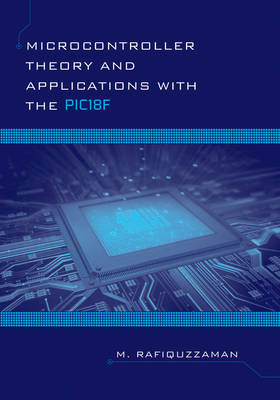
Microcontroller Theory and Applications
John Wiley & Sons Ltd (Verlag)
978-0-470-94769-2 (ISBN)
- Titel ist leider vergriffen;
keine Neuauflage - Artikel merken
This book presents the fundamental concepts of assembly language programming and interfacing techniques associated with typical microcontrollers. As part of the second edition′s revisions, PIC18F assembly language and C programming are provided in separate sections so that these topics can be covered independent of each other if desired. This extensively updated edition includes a number of fundamental topics. Characteristics and principles common to typical microcontrollers are emphasized. Interfacing techniques associated with a basic microcontroller such as the PIC18F are demonstrated from chip level via examples using the simplest possible devices, such as switches, LEDs, Seven–Segment displays, and the hexadecimal keyboard. In addition, interfacing the PIC18F with other devices such as LCD displays, ADC, and DAC is also included. Furthermore, topics such as CCP (Capture, Compare, PWM) and Serial I/O using C along with simple examples are also provided.
Microcontroller Theory and Applications with the PIC18F, 2nd Edition is a comprehensive and self–contained book that emphasizes characteristics and principles common to typical microcontrollers. In addition, the text:
Includes increased coverage of C language programming with the PIC18F I/O and interfacing techniquesProvides a more detailed explanation of PIC18F timers, PWM, and Serial I/O using CIllustrates C interfacing techniques through the use of numerous examples, most of which have been implemented successfully in the laboratory
This new edition of Microcontroller Theory and Applications with the PIC18F is excellent as a text for undergraduate level students of electrical/computer engineering and computer science.
Preface.
Credits.
1. Introduction to Microcontrollers.
1.1 Explanation of Terms.
1.2 Microcontroller Data Types.
1.3 Evolution of the Microcontroller.
1.4 Typical Microcontroller Applications.
2. Microcontroller Basics.
2.1 Basic Blocks of a Microcomputer.
2.2 Microcontroller Architectures.
2.3 Central Processing Unit (CPU).
2.4 Basic Concept of Pipelining.
2.5 RISC vs. CISC.
2.6 Functional Representation of a Typical Microcontroller The PiC18F4321.
Questions and Problems.
3. Introduction to Programming Languages.
3.1 Basics of Programming Languages.
3.2 Machine Language
3.3 Assembly Language.
3.4 High–Level Language.
3.5 Choosing a Programming Language.
3.6 Flowcharts.
Questions and Problems.
4. Microcontroller Memory and Input/Output (I/O).
4.1 Introduction to Microcontroller Memory.
4.2 Microcontroller Input/Output (I/O).
Questions and Problems.
5. PIC18F Architecture and Addressing Modes.
5.1 Introduction.
5.2 PIC18F Register Architecture.
5.3 PIC18F Memory Organization.
5.4 PIC18F Addressing Modes.
Questions and Problems.
6. Assembly Language Programming with the PIC18F: Part 1.
6.1 Basic Concepts.
6.2 PIC18F Instruction Format.
6.3 PIC18F Instruction Set.
Questions and Problems.
7. Assembly Language Programming with the PIC18F: Part 2.
7.1 PiC18F Jump/Branch Instructions.
7.2 PiC18F Test, Compare, and Skip Instructions.
7.3 PIC18F Table Read/Write Instructions.
7.4 PIC18F Subroutine Instructions.
7.5 PIC18F System Control Instructions.
7.6 PIC18F Hardware vs. Software Stack.
7.7 Multiplication and Division Algorithms.
7.8 Advanced Programming Examples.
7.9 PIC18F Delay Routine.
Questions and Problems.
8. PIC18F Hardware and Interfacing: Part 1.
8.1 PIC18F Pins and Signals.
8.2 PIC18F4321 I/O Instructions.
8.3 PIC18F Interrupts.
8.4 PIC18F Interface to and LCD (Liquid Crystal Display).
8.5 Interfacing PIC18F4321 to a Hexadecimal Keyboard and a Seven–segment Display.
Questions and Problems.
9. PIC18F Hardware and Interfacing: Part 2.
9.1 PIC18F Timers.
9.2 Analog Interface.
9.3 Serial Interface.
9.4 PIC18F4321 Capture/Compare/PWM (CCP) Modules.
9.5 DC Motor Control.
Questions and Problems.
10. Basics of Programming the PIC18F Using C.
10.1 Introduction to C Language.
10.2 Data Types.
10.3 Bit Manipulation Operations.
10.4 Control Structures.
10.5 Structures and Unions.
10.6 Functions in C.
10.7 Macros.
10.8 Configuring PIC18F4321 I/O Ports Using C.
10.9 Programming PIC18F4321 Interrupts Using C.
10.10 Programming the PIC18F4321 Interface to LCD Using C.
10.11 PIC18F on–chip Timers.
10.12 Programming the PIC18F4321 on–chip A/D Converter Using C.
10.13 Interfacing and External D/A (Digital–to–Analog) Converter Using C.
10.14 PIC18F SPI Mode for Serial I/O Using C.
10.15 Programming the PIC18F4321 CCP Modules Using C.
10.16 DC Motor Control Using PWM Mode and C.
Questions and Problems.
Appendix A: Answers to Selected Problems.
Appendix B: Glossary.
Appendix C: PIC19F Instruction Set (Alphabetical Order).
Appendix D: PIC18F Instruction Set Details.
Appendix E: PIC18F4321 Special Function Registers.
Appendix F: Tutorial for Assembling and Debugging a PIC18F Assembly Language Program Using the MPLAB.
Appendix G: Tutorial for Compiling and Debugging a C–Program Using the MPLAB.
Appendix H: Interfacing the PIC18F4321 to Personal Computer Using PICKIT 3.
Bibliography.
Index.
| Verlagsort | Chichester |
|---|---|
| Sprache | englisch |
| Maße | 185 x 257 mm |
| Gewicht | 860 g |
| Themenwelt | Technik ► Elektrotechnik / Energietechnik |
| ISBN-10 | 0-470-94769-1 / 0470947691 |
| ISBN-13 | 978-0-470-94769-2 / 9780470947692 |
| Zustand | Neuware |
| Informationen gemäß Produktsicherheitsverordnung (GPSR) | |
| Haben Sie eine Frage zum Produkt? |
aus dem Bereich



